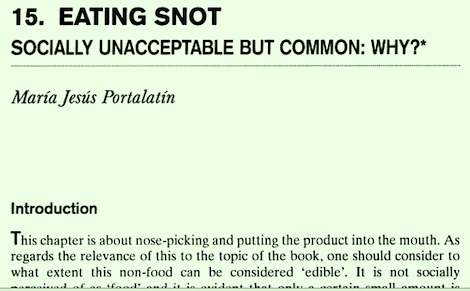Marc Abrahams's Blog, page 499
April 17, 2013
Reproductive effects of wearing a kilt [Scottish Medical Journal]
Men of Scotland, there are facts for you to ponder, in this new medical study:
“‘Real men wear kilts’. The anecdotal evidence that wearing a Scottish kilt has influence on reproductive potential: how much is true?” Erwin J.O. Kompanje [possibly pictured here], Scottish Medical Journal, vol. 58, no 1, February 2013, e1–e5. The author writes:
“Background and aims: There are anecdotal reports that men who wear (Scottish) kilts have better sperm quality and better fertility. But how much is true? …
“Methods and results: Analysis of literature concerning scrotal temperature and spermatogenesis and fertility.Wearing a Scottish kilt in a traditional (‘regimental’) way may have clear health-related benefits. Kilt wearing likely produces an ideal physiological scrotal environment, which in turn helps maintain normal scrotal temperature, which is known to be beneficial for robust spermatogenesis and good sperm quality.
“Conclusion: Based on literature on scrotal temperature, spermatogenesis and fertility, the hypothesis that men who regularly wear a kilt during the years in which they wish to procreate will, as a group, have significantly better rates of sperm quality and higher fertility.”

The Assessed Un-idealness of Italian cardiologists
A new look at the habits and health prospects of some of the planet’s most glamorous medicos:
“Cardiovascular Risk Profile and Lifestyle Habits in a Cohort of Italian Cardiologists (from the SOCRATES Survey),” Pier Luigi Temporelli, Giovanni Zito, Pompilio Faggiano, and the SOCRATES Investigators, American Journal of Cardiology, epub April 12, 2013. The authors, at Cardiology Division in Veruno, Ambulatorio di Cardiologia in Napoli, and Spedali Civili and University of Brescia, Italy, report:
“the average cardiovascular profile of Italian cardiologist is unlikely to be considered ideal or even favorable according to recent statements and guidelines regarding cardiovascular risk.”
(Thanks to investigator Ivan Oransky for bringing this to our attention.)

Some vexed machines
Donald Simanek compiled a long, yet undoubtedly very, very partial list of patents for machines that do not and, by their nature, cannot work as described. (Thanks to investigator Timmy Barton for bringing it to our attention.) Here’s one item:
1857 [No. 1330] Peter Armand le Comte de Fontainemoreau of London, Agent. Hydraulic motor. The “bucket brigade” arrangement of buckets or bellows on a belt over two pulleys, with everything below the top pulley immersed in a tank of water. Drawing from Dircks (1861) p. 478. The patent describes it more clearly than the picture.
The apparatus is composed of a number of hollow elastic buckets or bellows, partly immersed in water, made to pass over two pulleys. Each bellows is furnished with leaden weights at the bottom, which forces the air contained in the bellows on one side, to pass by means of connecting tubes into those buckets or bellows that are on the opposite side. The bellows are fitted to slotted links, and connected together so as to form an endless chain, which passes over the two pulleys.

April 16, 2013
Genetics: App for Icelanders who are apt to sleep with relatives
The News of Iceland web site reports:
New App Prevents Icelanders from Sleeping With their Relatives
The Icelandic population is very small and all Icelanders are related. But yet, it is big enough so everyone doesn’t know one another. This means that each and every Icelander that is in a relationship, is dating a relative. In most cases those relations are distant. But not always. But how can they know? …
Three engineers made an app for the ‘Íslendingabók’ database. People can now easily, and on the go, look up how they are related to other Icelanders. And a precious feature, using the bump technology, allows people that meet to just bump their phones together, to instantly see if they are too related to take things any further. The engineers’ slogan for this feature was: “Bump the app before you bump in bed”.
The database is online. The app is available from several sites.
(Thanks to investigator Geoffrey Miller for bringing this to our attention.)

What’s on TV: The NYT recommends the Ig Nobel Documentary
The New York Times today recommends this TV program:
1 P.M. (TV5Monde) QUAND LA SCIENCE FAIT RIRE (2012) What effect do roller coasters have on asthma treatments? Does swearing ease pain? Do we swim more quickly in water or in syrup? The director of this program, Roland Portiche, whose title translates as “When Science Is Funny,” looks at the Ig Nobel Prize, a satirical award presented annually for studies like these by The Annals of Improbable Research, a scientific journal in Cambridge, Mass., created to “first make people laugh, and then make them think.” (In French, without English subtitles.)
BONUS: Telerama’s take on the program
BONUS: The official word from TV5Monde

Looking at looking at looking in elevators
Robert Krulwich, on NPR, looks at the research that looked at people looking or not looking at other people in elevators:
She’s in Finland now, getting her Ph.D. at the University of Jyvaskyla, but before that, when she was in Adelaide, Australia, she studied elevator behavior. Rebekah Rousi [pictured here] hung around two tall office towers in town, riding elevators up and down day after day, looking for patterns. When a bunch of people get into an elevator, she wondered, do they segregate in any predictable way? Do tall ones stand in the back? Do men stand in different places than women? Who looks where?…
The men who flocked to the back, who had a better view of their fellow passengers, were consistently older, more “senior” (I’m not sure how she knew that, but it’s in her posted paper) and many of them “weren’t concerned with ‘getting caught’ looking in the mirror.” They gazed freely, suggesting a sense of privilege. Younger, less powerful men seemed to avoid that space…

April 15, 2013
Cat on a keyboard, then and again
Watching this old video of a cat on a keyboard might give you a deeper appreciation for a later invention: PawSense, software that detects when a cat is walking across your computer keyboard. Chris Niswander, the inventor of PawSense, was awarded the 2000 Ig Nobel Prize in computer science.

They simulated the stock picking abilities of ten million monkeys
Random accumulation and simulated monkeys figure quite deliberately in this two-part study (it parallels the recent findings of the Ig Nobel Prize-winning team who won their Ig for showing that promoting people at random can produce better results than promoting by other methods):
“An evaluation of alternative equity indices. Part 1: Heuristic and optimised weighting schemes” and ” An evaluation of alternative equity indices. Part 2: Fundamental weighting schemes”, Andrew Clare [pictured here], Nick Motson and , Cass Business School, published online, March 2013. (Thanks to investigator Frederic Lepage for bringing this to our attention.) The authors explain:
“In his book Fooled by Randomness, Nassim Taleb warns us that financial market participants often mistake unsystematic, random events for systematic and explicable phenomena. Or as Professor Taleb puts it: ‘If one puts an infinite number of monkeys in front of (strongly built) typewriters and lets them clap away (without destroying the machinery), there is a certainty that one of them will come out with an exact version of the ‘Iliad.’ Once that hero among monkeys is found, would any reader invest [their] life’s savings on a bet that the monkey would write the ‘Odyssey‘ next?’
“7.1 A simian experiment: To try to distinguish between ‘luck and design’ we set up an experiment. Instead of determining weights at the end of each calendar year using the techniques described in Sections 2 and 3, and then forming the index every year using the appropriate weights, we employed a more random approach. In essence we programmed the computer to simulate the stock picking abilities of ten million monkeys.”
BONUS: Gismodo’s take on the matter

April 14, 2013
What snot for dinner
 Chapter 15 of the book Consuming the Inedible: Neglected Dimensions of Food Choice is called ”Eating Snot – Socially Unacceptable but Common: Why?” Maria Jesus Portalatin wrote that chapter. Investigator Wilson Maslin brought it to our attention, and now we bring it to yours.
Chapter 15 of the book Consuming the Inedible: Neglected Dimensions of Food Choice is called ”Eating Snot – Socially Unacceptable but Common: Why?” Maria Jesus Portalatin wrote that chapter. Investigator Wilson Maslin brought it to our attention, and now we bring it to yours.
BONUS; The 2001 Ig Nobel Prize-winning study ”A Preliminary Survey of Rhinotillexomania in an Adolescent Sample,” Journal of Clinical Psychiatry, vol. 62, no. 6, June 2001, pp. 426-31. The abstract explains:
BACKGROUND: Rhinotillexomania is a recent term coined to describe compulsive nose picking. There is little world literature on nose-picking behavior in the general population.
METHOD: We studied nose-picking behavior in a sample of 200 adolescents from 4 urban schools.
RESULTS: Almost the entire sample admitted to nose picking, with a median frequency of 4 times per day; the frequency was > 20 times per day in 7.6% of the sample. Nearly 17% of subjects considered that they had a serious nose-picking problem. Other somatic habits such as nail biting, scratching in a specific spot, or pulling out of hair were also common; 3 or more such behaviors were simultaneously present in 14.2% of the sample, only in males. Occasional nose bleeds complicating nose picking occurred in 25% of subjects. Several interesting findings in specific categories of nose pickers were identified.
CONCLUSION: Nose picking is common in adolescents. It is often associated with other habitual behaviors. Nose picking may merit closer epidemiologic and nosologic scrutiny.

Mysterious Citation: Retracted misophonia re a yawning mother
This week’s Mysterious Citation of the Week is:
“Retracted: Fear of the Yawning Mother: A Case of Misophonia,” Noel Collins, Australasian Psychiatry, 18.1 (2010): 71-72.

Marc Abrahams's Blog
- Marc Abrahams's profile
- 14 followers




